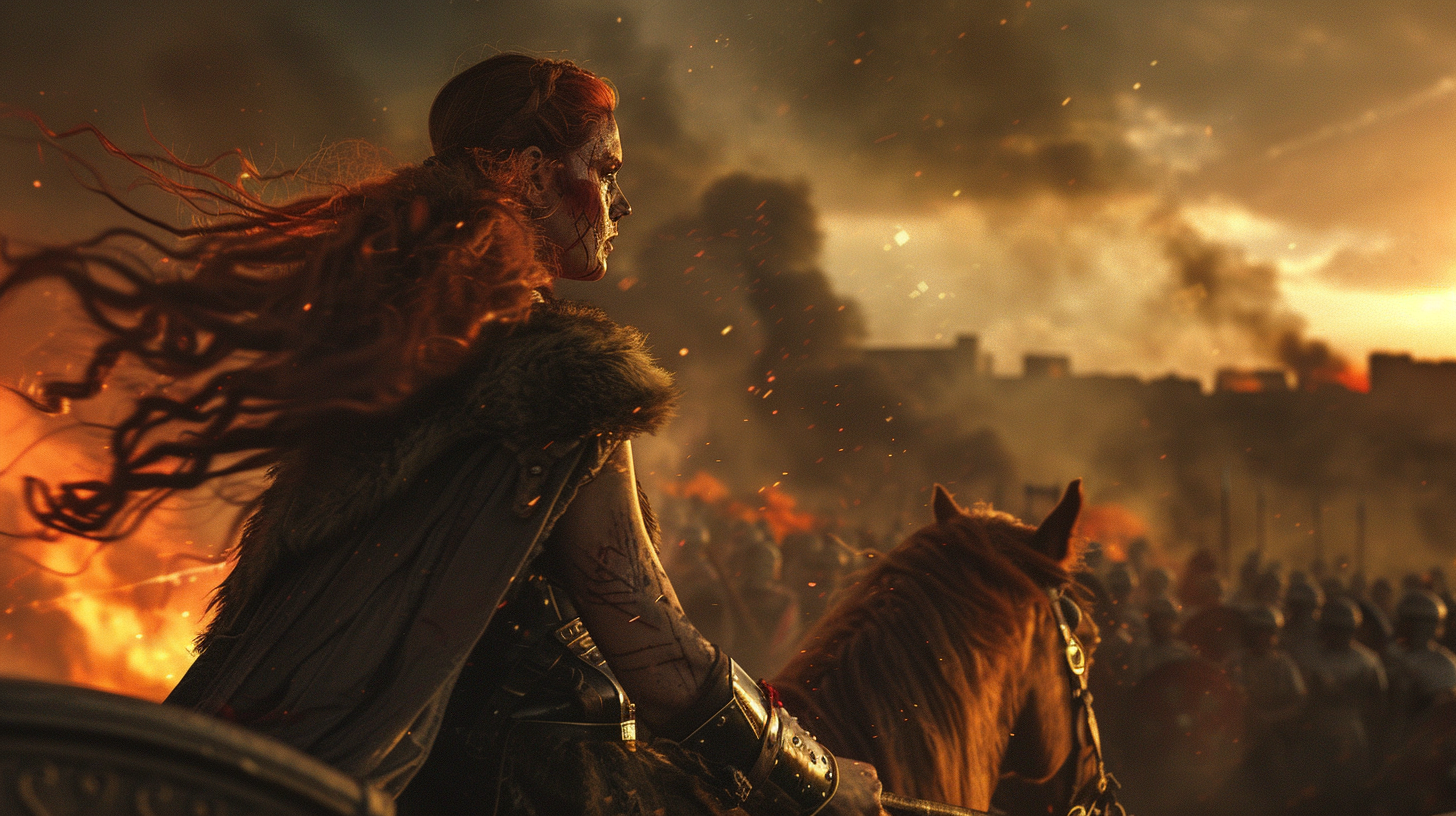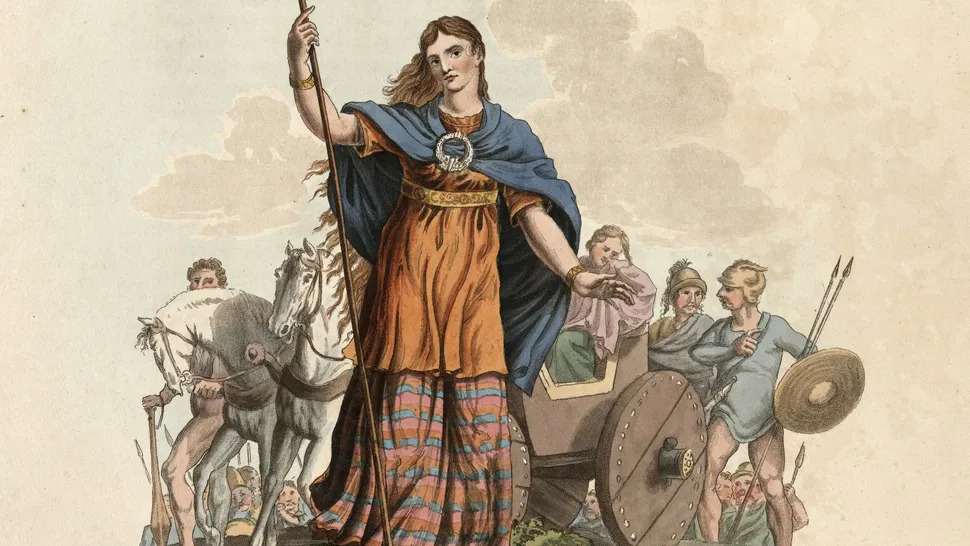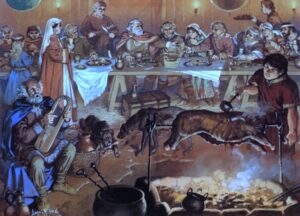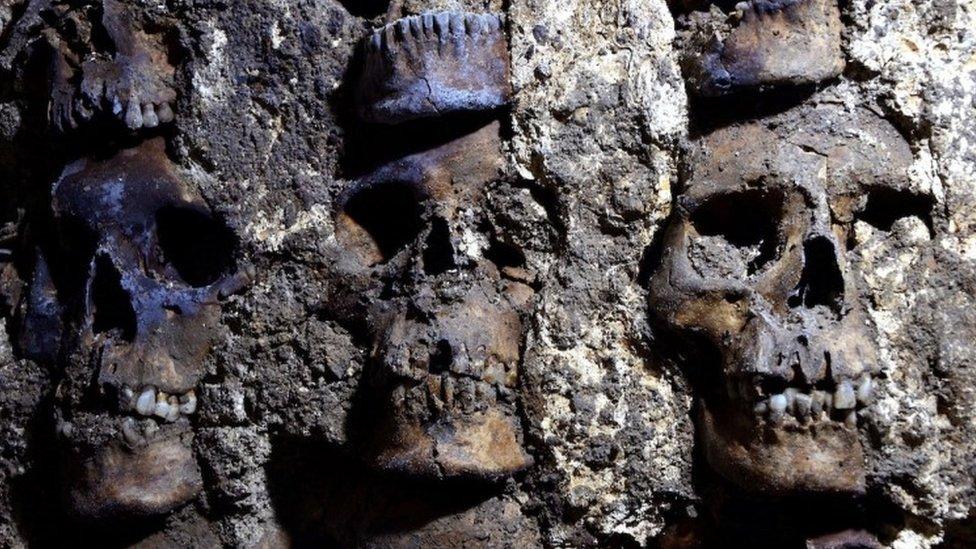
Boudica was Queen of the Iceni tribe in 60AD, ruling what is now East Anglia.
When her husband died, the Romans flogged her publicly and raped her two daughters. She responded by leading a revolt that destroyed three Roman cities and slaughtered an estimated 80,000 people in a matter of weeks. So fierce was her anger.
THEN SHE VANISHED, leaving nothing behind but mass graves and a layer of burnt earth that still lies beneath modern London.
The Romans chose the wrong woman to mess with.

The Smell of Londinium Burning
The smell hits you first. Not clean woodsmoke, but the greasy, sweet stench of burning fat. Human fat. It clings to the back of your nose, makes you gag, but you cannot escape it because it is everywhere. The air itself is thick with it.
You are in Londinium in 60AD, and the city is dying.
The flames are not red. They are white-hot, so intense they make a sound like screaming wind. Buildings collapse inward, sending up great plumes of sparks that swirl like living things. The heat is unbearable even from a distance. Your skin feels tight, ready to split.
In the street, a woman runs with her hair on fire. She does not get far. A spear takes her between the shoulders, and she goes down, still burning. A child, perhaps six years old, sits beside a collapsed wall, crying for his mother. He will cry for three more minutes before the smoke takes him. An old man stumbles from a doorway, his clothes ablaze, his hands held out as if pleading. No one helps. No one can.
War Cries and Howls Of Rage Filled The Burning Air
The Iceni are everywhere, their faces and bodies painted, their voices raised in something between a war cry and a howl of rage. They are not taking prisoners. A Roman merchant is dragged into the open, forced to his knees. They cut his throat and leave him thrashing in the dust. A woman clutching a baby tries to surrender. It makes no difference. Both die.
This is not a battle.
This is extermination.
The heat grows unbearable. The flames have surrounded the forum now, trapping hundreds inside. You can hear them screaming, a sound that rises above even the roar of the fire. It goes on for a long time. Then it stops.
By morning, Londinium will be ash. Some believe that as many as fifteen thousand people will be corpses. And if you dig down through the centuries, down through medieval foundations and Victorian cellars, you will find the proof. A layer of burnt red clay, baked hard by unimaginable heat, mixed with melted glass and charred bone. The earth itself remembers what happened here.
Boudica remembers, too.
An entire civilisation’s layer of life and trade, abruptly replaced by a red line of ash.

What Broke the Queen
Months earlier, Boudica had been a different woman. Queen of the Iceni, widow of King Prasutagus, mother of two daughters whose names history never recorded. Her husband had tried to protect them all by leaving half his Kingdom to Rome, half to his daughters. A compromise. A bridge between two worlds.
The Romans foolishly tore the bridge down.
As soon as Boudica’s husband was gone, they stabbed her in the back metaphorically and took the entire Kingdom.
When Boudica rightly protested, shocked by their practice, they stripped her in front of her people and flogged her until her back was raw meat. Then they took her daughters, and raped them whilst their mother was held down and forced to watch.
They wanted to humiliate her, warn her and keep her silent. Just as a woman should be.
The Romans thought this would break her. They thought public humiliation would crush any thought of rebellion. With irritated smirks, they thought Boudica had been dealt with.
They were wrong. More wrong than they could ever have imagined.
Three Cities Die In A Matter Of Weeks
Camulodunum—modern Colchester—died first. It burned for two days. The retired Roman soldiers who had settled there, who had stolen Trinovantes’ land as their reward for service, barricaded themselves in the Temple of Claudius. They held out for forty-eight hours. Sure, they’d be safe. Then the doors came down. Every man inside was butchered where he stood.
The Iceni Were Not Fussy. They Wanted Revenge
THE ICENI KILLED EVERYONE. The Iceni were not fussy. The Iceni did not choose. This was not a battle; this was extermination. The old. Women. Infants. Boudica’s forces were not interested in slaves or ransom. They wanted blood.
When archaeologists excavated Colchester in the twentieth century, they found hasty mass graves, the bodies dumped in without ceremony. One skeleton had a sword cut on the jaw. Another had been decapitated.
Fear Started To Take Hold. The City Was Evacuated.
Londinium came next. The Roman governor, Suetonius, arrived with his cavalry, took one look at the undefended trade hub on the Thames, and made a soldier’s decision. The city could not be held. He ordered an evacuation. Anyone who could march was to leave immediately. The rest were abandoned.
Perhaps twenty thousand people remained when Boudica arrived.
She burned the city to the ground.

The Mass Graves Of Hell Under London City
The fire was so intense that it baked the clay beneath the city into brick. That burnt layer, half a metre thick in places, spreads across what was once Roman Londinium. Victorian workers, digging foundations centuries later, broke through into that crimson stratum and wondered what catastrophe had created it. Now we know. It is a mass grave, sealed in fire.
Hideous Slaughter Ensued
The Roman historian Cassius Dio claimed that Boudica’s forces impaled noble Roman women on stakes, cut off their breasts and sewed them to their mouths in grotesque mockery.
Whether this is true or propaganda is debated. What is not debated is that Londinium was annihilated. Tacitus, writing decades later, said the Britons had no interest in prisoners or profit. They wanted only slaughter.
Verulamium—St Albans—was third. A prosperous town, inhabited mainly by Britons who had adopted Roman ways. It did not save them. Boudica’s army swept through and left nothing but corpses and ash. The same destruction layer. The same evidence of total obliteration.
Three cities gone. Eighty thousand dead. All in a matter of weeks.
The Last Battle
Suetonius finally made his stand somewhere along Watling Street, the location now lost to history. He had ten thousand men. Boudica commanded over a hundred thousand warriors. But Suetonius chose his ground carefully—a narrow defile, woods protecting his flanks, preventing the Britons from using their numbers.
The Iceni charged. The Romans held.
What followed was a massacre. The legionaries threw javelins in coordinated volleys, then advanced in wedge formation, shields locked, stabbing methodically. The Britons, brave but disorganised, were ground down. When they tried to retreat, their own supply wagons blocked the escape. The families who had come to watch the victory were slaughtered alongside the warriors.
Tacitus claims eighty thousand Britons died that day. Roman casualties numbered in the hundreds. The figures are likely exaggerated, but the defeat was absolute.
Boudica Vanished
Boudica vanished. Tacitus says she poisoned herself. Cassius Dio claims she fell ill and died. Neither account can be verified. No grave has ever been found. The woman who nearly drove Rome from Britain simply disappeared.
What the Earth Remembers – Deep Dive

The layer of burnt destruction beneath London, Colchester, and St Albans is no legend. It is a physical fact. In London, this layer—officially the Boudican Fire Horizon—dates to 60-61 CE through coin evidence and pottery. It contains carbonised wood, melted glass, baked clay, and cremated human remains. The heat required to create such destruction was immense, far beyond accidental fire.
At Colchester, excavations revealed the ruins of the Temple of Claudius, where the final defenders died. Mass graves from this period contain bodies with violent trauma—sword cuts, evidence of hasty burial. At St Albans, the Roman buildings were obliterated, buried beneath ash and burnt clay.
The only real issue is with the apparent number of people who were killed. It’s true that Boudica and her forces carried out mass slaughter, but the figures come from Roman historians, so we need to be cautious.
But why would Roman historians say more people were killed than what actually happened? It’s propaganda.
By inflating the numbers, it makes their victory over Boudica even greater. Suddenly, the great Roman army defeated this monster of an enemy and it shows how strong they were to regain control of the situation. Their soldiers become heroes to the everyday Roman. The might of Rome is reinforced while they forget that Boudica did undoubtedly kill tens of thousands of Romans.
The Iceni Were Cultured, But This was Pushed Too Far
The Iceni were not savages. They were sophisticated metalworkers who minted coins and created magnificent gold torcs. The Snettisham Hoard, discovered in Norfolk, contained treasures of extraordinary craftsmanship. They were wealthy, cultured, and cooperative with Rome—until Rome pushed too far.
After crushing the revolt, Rome changed tactics. The new procurator advocated reconciliation rather than punishment. The destroyed cities were rebuilt. Londinium became one of the most important settlements in Roman Britain. But the memory remained.
Boudica Never Forgotten Until this Very Day
FOR CENTURIES, people have searched for Boudica’s grave. Victorian legend claimed she was buried beneath King’s Cross Station, standing upright in her chariot. There is no evidence for this. More likely, she was buried somewhere in Iceni territory, perhaps in an unmarked grave. Two thousand years of ploughing and building have erased the trail.
She is gone. But her story is not forgotten.
A woman will protect her children no matter what. Revenge was her war cry.
If you dig beneath London, you will find her legacy. That burnt red layer, thick with ash and melted glass and bone. A scar that will not heal. A reminder that civilisation is fragile, that rage once ignited burns everything, and that sometimes the dead leave marks that time cannot erase.
Boudica has no grave, no monument. She exists now only in that burnt earth, in ancient texts, and in the question that haunts her story: what drives a human being to become this? What breaks inside when violation becomes so absolute that mercy dies with it?
The answer lies beneath your feet, in the red clay under London, waiting in the dark.







